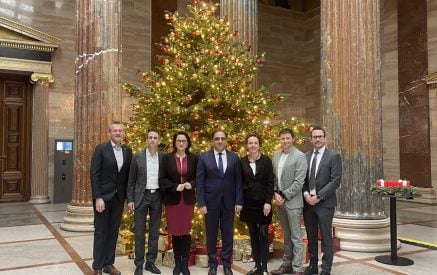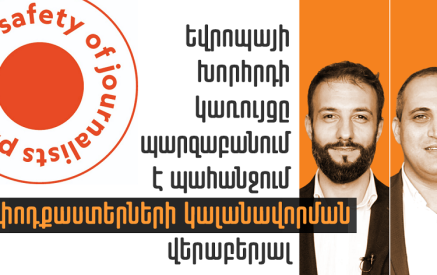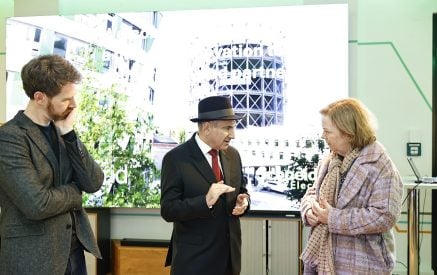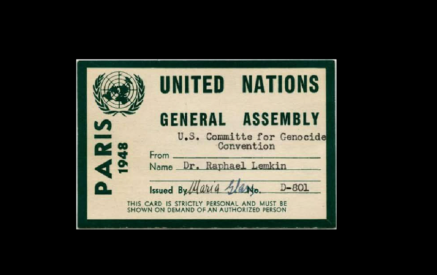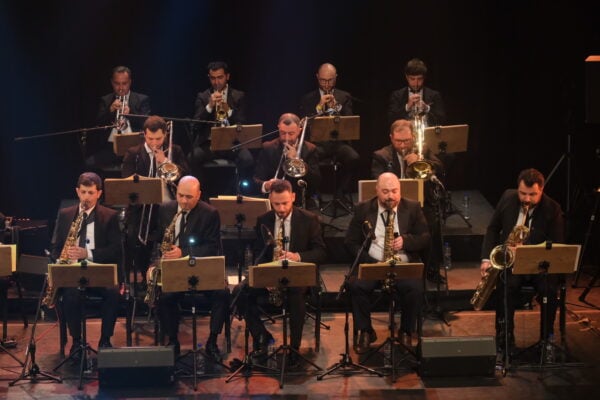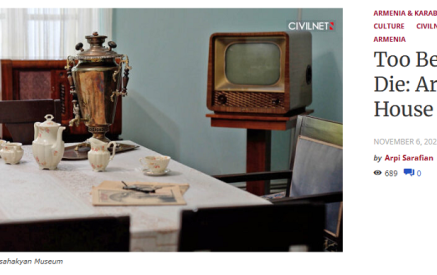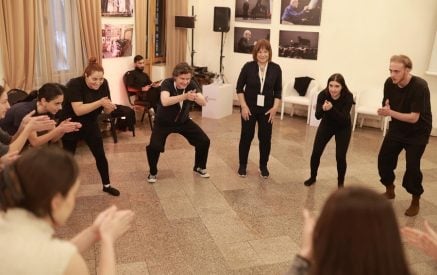by Sona Mirzoyan
YEREVAN — For more than a decade, Davit Melkonyan has been part of the Armenian State Jazz Orchestra, a musical institution deeply embedded in Armenia’s cultural fabric. Today, as its artistic director, Melkonyan stands at the crossroads of tradition and transformation, working to expand the orchestra’s reach while preserving its artistic heritage. Alongside him, music producer John Grigoryan, known for his work with the Armenian Navy Band and other landmark jazz projects, offers a broader view of the industry’s evolution — from the challenges of monetization to the impact of technology on creativity.
Founded in 1938 by composer Artemi Ayvazyan, the Armenian State Jazz Orchestra is among the oldest jazz ensembles in the former Soviet Union. In the Soviet era, it was one of the few orchestras permitted to perform jazz — a genre then considered Western and often restricted. The ensemble not only introduced generations of Armenians to jazz but also helped shape a unique Armenian jazz language that blended swing, folk melodies, and classical training. Today, it continues that legacy as one of the country’s leading state-supported musical institutions.
A jazz saxophonist and composer, Melkonyan strives to achieve a synthesis between academic jazz and the current experimental sounds.
“The years in the orchestra have taught me a lot,” Melkonyan said. “Especially here in Armenia, where the orchestra has played a key educational role for generations. Those years helped me understand the patterns, the needs, and the opportunities for renewal.”
Building on Experience
Having joined the orchestra in 2012, Melkonyan grew within its soundscape, learning its rhythm and traditions from the inside. His journey mirrors the evolution of the orchestra itself — from Soviet roots to post-independence reinvention. Over the years, he witnessed its artistic growth and its quiet influence as both a performance ensemble and an educational institution for young musicians.
Now, as artistic director, he channels that experience into a renewed vision, one that values both preservation and reinvention.
“From fresh approaches to notation to the creation of new works and the updating of our archives — every layer has helped the orchestra evolve,” he explained. “That collective memory is our foundation.”
Expanding the Program and Audience
Since taking up leadership in 2023, Melkonyan has reshaped the orchestra’s artistic direction, focusing on inclusivity, education and innovation.
Under his guidance, the orchestra now follows a structured concert calendar and hosts smaller ensemble performances in its hall. A series of educational events for young musicians — a first in the orchestra’s history — has become part of its ongoing activities.
“The repertoire has grown significantly — new compositions, reimagined classics, and collaborations with musicians outside the orchestra. As a result, our archive has expanded, and our audience has become younger,” Melkonyan shared.
One of Melkonyan’s most distinct innovations has been bringing Armenia’s underground jazz scene into collaboration with the orchestra’s academic platform. This move has invigorated both the ensemble and its listeners.
By “academic platform,” Melkonyan refers to the orchestra’s formal, conservatory-based foundation — its link to Armenia’s classical institutions — in contrast with the informal, improvisational energy of the city’s underground jazz community.
The idea was born from a desire to broaden the orchestra’s demographic. “Our audience used to be mostly 40 or 50 years old,” Melkonyan recalled. “I wanted to see younger faces in the hall. That’s how the idea of merging the academic and underground worlds was born.”
The collaboration began with the New Quintet — one of Yerevan’s most prominent experimental jazz collectives — and has since evolved into a recurring creative exchange. For Melkonyan, these projects create what he calls “positive stress” — an energy that drives artistic growth.
“Such partnerships force us to think bigger and organize better,” he said. “They make the orchestra’s daily life more dynamic and open up new ways to connect with audiences.”
Touring the World with Aznavour’s Legacy
In the summer of 2024, the Armenian State Jazz Orchestra embarked on an international tour with a program dedicated to Charles Aznavour’s centennial. The tour reaffirmed the orchestra’s dual identity: a bearer of national heritage and an ambassador of Armenian artistry abroad.
Developed under the initiative of Artyom Naghdyan and the Ministry of Education, Science, Culture and Sports, the project took the orchestra to Latin America, Ethiopia, several European countries and Kazakhstan.
The tour featured 12 newly-arranged Aznavour songs, adapted for full jazz orchestra by Arman Peshtmaljian and Vahagn Hakobyan.
“It was a unique joy,” Melkonyan said. “Not only because it was our project with the State Philharmonia of Armenia, but because during Aznavour’s lifetime, such orchestral jazz arrangements of his music had never been made.”
He noted that audiences abroad differed from those at home. “During our Q&A sessions at on-site master classes, people were much more open and interactive,” Melkonyan observed. “At home, audiences can be a bit reserved, but that’s changing.”
The tour also featured acclaimed Armenian vocalists Inga Arshakyan and Gor Sujyan, both of whom brought distinctive artistry to the performances.
Jazz and the Armenian Music Ecosystem
While Melkonyan and his peers are expanding creative boundaries, the broader Armenian music industry faces systemic challenges. Music producer John Grigoryan, who has worked on numerous acclaimed projects including Armenian Navy Band, believes that the core issue lies not in talent, but in infrastructure.
“Armenia has musicians who can create and perform at a world-class level,” Grigoryan noted. “The problem is not talent, it is the pipes to the world. Monetization fails at the door with too few venues, in the cloud with tiny payouts, and at the lawyer’s desk with uncollected rights.”
He points to a combination of factors — a small domestic market, weak systems for intellectual property protection, and post-Soviet gaps in professional capacity — as the main barriers to creating sustainable careers. “For years it ran on a bit from here and a bit from there,” Grigoryan added. “Music rarely became a sustainable business.”
According to Grigoryan, the global music industry now “lives inside the attention economy,” where success depends on how long listeners stay engaged.
“Retention time and skip rate sit at the center of the system,” he said. “So arrangement choices shift — choruses arrive sooner, intros compress, and production optimizes for the first few seconds and the phone speaker.”
Algorithmic and AI-driven playlists now shape listening habits, clustering audiences around familiar sounds and rewarding predictability. “Personalization brings both more discovery and more sameness,” Grigoryan observed. “Classical and jazz still reward patience, but they risk becoming artifacts rather than living markets.”
For Armenian jazz, that risk is real. Long-form, improvisational works thrive in live settings, but often struggle for attention on digital platforms optimized for immediacy.
New Models and the Role of State Support
Grigoryan also highlights the shifting value of live performance in a digitized era.
“Total digitization is changing the value of live performance, making the show a scarce, unrepeatable moment,” he said. “The challenge is upstream — to fill the room, you must first win the race inside the attention economy.”
He sees potential in AI tools, which lower production costs and shorten the creative cycle, enabling artists to reach broader markets. Yet, they also disrupt traditional service ecosystems — from recording studios to session work.
“In Armenia’s small market,” he added, “state support and sponsorship serve as cultural ballast. They preserve identity in the digital age while creating room to export work. Understanding the shifts in attention and distribution — and working fluently with AI tools — is now part of the craft.”
For Melkonyan, these shifts only underscore the importance of jazz as a living form of expression. “What’s happening in our society today is mirrored in our music,” he said. “We’re giving new life to old works because we’re collectively trying to understand who we are and where we’re headed.”
He sees jazz as “freedom within structure” — a space where Armenia’s complex cultural story can be heard anew. Tracing the orchestra’s lineage, he honors pioneers such as Artemi Ayvazyan, Konstantin Orbelyan, Armen Martirosyan and Armen Hyusnunts, each of whom, he says, brought new colors to the orchestra’s sound and purpose.
“The orchestra still carries that ambition — to create an environment around us that reflects our identity. There’s potential, and that’s our mission.”
Leadership, for Melkonyan, remains both a challenge and a source of inspiration. “At first, keeping the balance between administration and creativity was difficult,” he admitted. “But now it’s easier, because that’s where the beauty lies.”
As he continues to guide the Armenian State Jazz Orchestra, Melkonyan’s mission aligns with Grigoryan’s observations: sustaining artistic innovation in a world defined by algorithms and fleeting attention. Both agree that the survival of Armenian jazz depends not only on talent, but on adaptability, finding harmony between artistry, technology, and audience connection.





